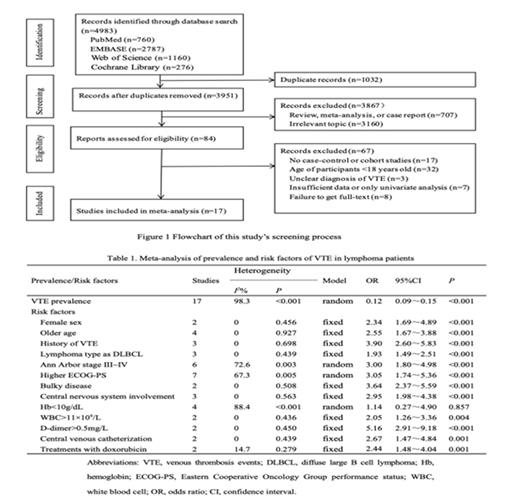Background: The prevalence and risk factors of venous thromboembolism (VTE) in lymphoma patients have been extensively studied, but with varying degrees of research quality and inconsistent findings. The primary objective of our study was to investigate the prevalence and identify risk factors associated with VTE in lymphoma patients.
Methods: We conducted a systematic search of PubMed, EMBASE, Web of Science, and Cochrane Library databases up to February 2023 to identify relevant studies investigating VTE in lymphoma patients. We calculated the pooled odds ratio using a fixed- or random-effect model and evaluated the quality of each study using the Newcastle-Ottawa Scale. To evaluate the robustness of our findings, we conducted sensitivity analysis. We also identified any potential publication bias using funnel plots and Egger's test. Two researchers independently assessed eligibility and extracted data to ensure accuracy.
Results: Our analysis included a total of 17 studies with a combined sample size of 4,983 lymphoma patients (Figure 1). The pooled prevalence of VTE among these patients was 12% (with a confidence interval of 0.09-0.15). Sensitivity analyses were performed, and the results were consistent with the overall pooled estimate. Our meta-analysis revealed that several factors were significant risk factors for VTE in lymphoma patients, including female sex, older age, history of VTE, DLBCL lymphoma type, Ann Arbor stage III~IV, higher ECOG-PS, bulky disease, central nervous system involvement, WBC count >11×10 9/L, D-dimer level >0.5mg/L, central venous catheterization, and treatments with doxorubicin ( P<0.05) (Table 1). However, the funnel plot suggested that there may be some potential publication bias, which was further confirmed by statistical tests. Nevertheless, the results of the trim-and-fill method demonstrated that the pooled estimate remained stable after the addition of nine “missing” studies.
Conclusions: Our study revealed that the pooled prevalence of VTE in OC was approximately 12% across lymphoma patients. Risk factors for VTE were identified which may aid in preventative measures for VTE in lymphoma patients.
Disclosures
No relevant conflicts of interest to declare.


